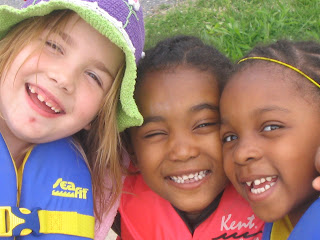Monday, April 30, 2007
Anacostia Haikus!
Fish have cancer there.
When sun shines in the river
the water is blue.
-Christina
"Pollution"
River in D.C.
It is really polluted
And it has sewage.
and
"Bird"
Dashes to river
just like a big rocket ship
Flying high in sky.
-Princess
Students write about the Anacostia trip
"We went to the Anacostia River. We got there by vans, trucks, and cars, and we rode on a little boat. Mr. Josh's company name was Earth Conservation Center-- the ECC. Mr. Josh was a boat rider/captain. We learned about sewers and ducks and birds and flowers and fish. He told us that if you litter and it starts raining, it will come out at the Anacostia River. Then, we saw a bird flying with a fish; it was very odd."
--Princess
"I've never been on an exciting boat ride. Josh said we shouldn't litter, because then the earth won't be healthy. I learned that a park is better for a river than buildings. The best thing for the edges of a river are wetlands and miles of trees, especially the Weeping Willow. Then, we have a healthy river.
The Indians discovered the river first. They called it the "Country Trading Center." The one thing I noticed was everywhere we went there was lots of sewage and Captain Josh said, if you litter on the ground, the trash will go to the river. "
--Devinity
"Captain Josh told us about littering, then Nia started chanting, "No more littering!" Captain Josh said maybe you should save your energy and say it to the buildings. We all said it loud to the people on the bridges and in cars."
--Aiyana, Princess, Quennie, Devinity
Thursday, April 26, 2007
No More Litter!
 The After 4 gang has been learning about our precious water resources and some of the issues we need to think about to protect the Chesapeake Bay watershed.
The After 4 gang has been learning about our precious water resources and some of the issues we need to think about to protect the Chesapeake Bay watershed. People simply dump their trash into the Anacostia. Storm drains from the District of Columbia empty into the river. And when it rains heavily, much of the city's sewage system overflows and spills into the river as well.
That's right: When we get a heavy rain, your toilets dump right into the Anacostia. Hard to believe, but true.

Josh takes people on tours of the Anacostia almost every day. There is still wildlife on the river. He showed us osprey nests. We also saw cormerants and seagulls and a great blue heron.
We also saw some Canada geese. But Josh says the geese are a problem: They eat important wetland plants. Wetland plants along the river's shoreline act as a filter, remover harmful pollutants from the river. We need more wetland areas, but they have to be fenced to keep the Canada geese out.
Now, people give the river hardly a thought. They also dump their automobile tires into the Anacostia. Josh said the Conservation Corps at one point cleaned up a small portion of the river and collected more than 400 automobile tires. Also, everywhere you look trash is floating on the river, mostly soda bottles and plastic packaging.
 This past weekend, the Conservation Corps filled 320 bags with trash from Kingman Island near RFK Stadium. But when we passed the island yesterday, the trash was back. Lots of trash.
This past weekend, the Conservation Corps filled 320 bags with trash from Kingman Island near RFK Stadium. But when we passed the island yesterday, the trash was back. Lots of trash.The reason for so much trash is that people litter everywhere. And the litter gets washed down the storm drains and into the Anacostia. So the After 4 gang began to chant: No more litter! No more litter!
The chant grew louder and louder. It went on and on.
No more litter!
Wednesday, April 25, 2007
Monday, April 16, 2007


Recently in class we've been focused on learning about photosynthesis and vascular plant systems. These images show a papier mache tree the gang made. The leaves are made from their handprints, and if you look closely, you can see that built onto the side are papier mache layers that fold out, labeled: Outer Bark, Phloem, Cambium, and Xylum.
The class got so excited about their knowledge of how trees use light energy to make glucose, that they expressed a great interest in having a play on the subject. In this image, the kids are cutting out different lengths of light waves as costumes. There was much fuss over who would play the sun, so in addition to that role, we designated girls to play different lightwaves that penetrate our atmosphere, and thus a tree's leaves. Shown here are three little smiling rays!
Saturday, April 14, 2007
Things Are Blooming
 Our garden is in its second year now and clearly some of the plants that we started last year from seeds are very happy. What a great thing to see them coming back so vigorously and in such good health.
Our garden is in its second year now and clearly some of the plants that we started last year from seeds are very happy. What a great thing to see them coming back so vigorously and in such good health. Last year we had good success with our strawberry plants. Every morning, the kids would come to school excited and asking if they could pick the latest strawberry they'd found on the verge of ripeness. We harvested quite a few.
Last year we had good success with our strawberry plants. Every morning, the kids would come to school excited and asking if they could pick the latest strawberry they'd found on the verge of ripeness. We harvested quite a few.




